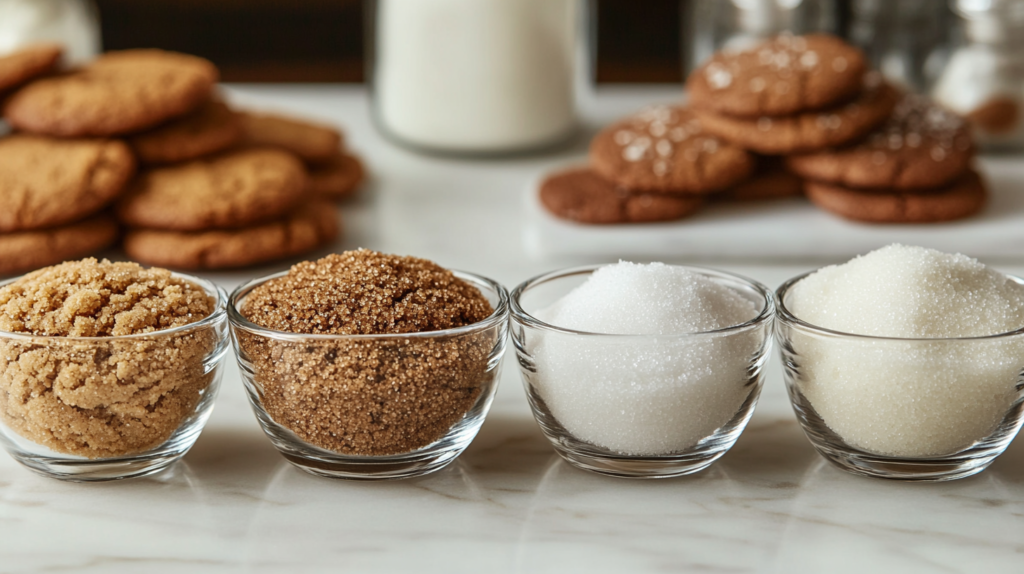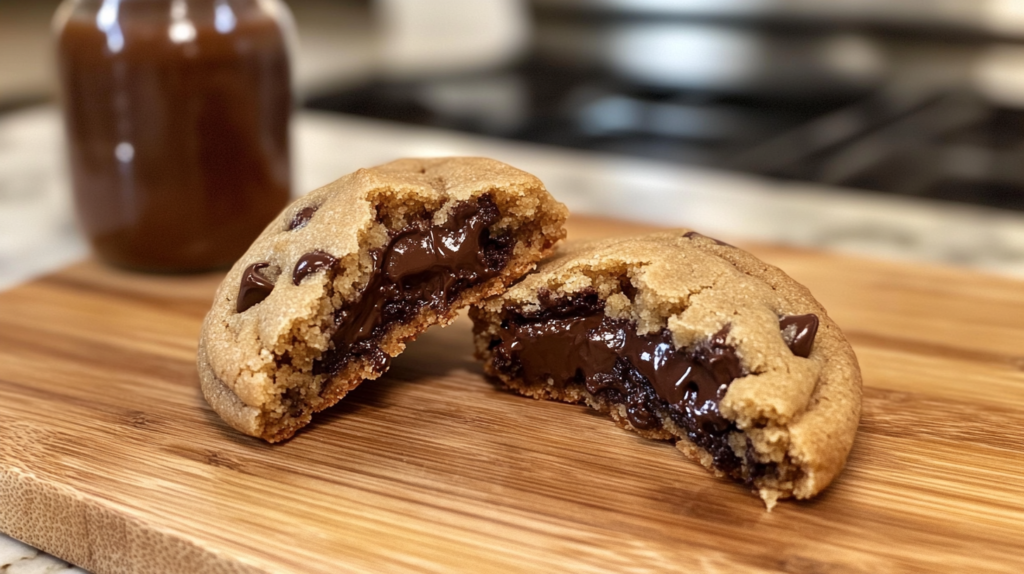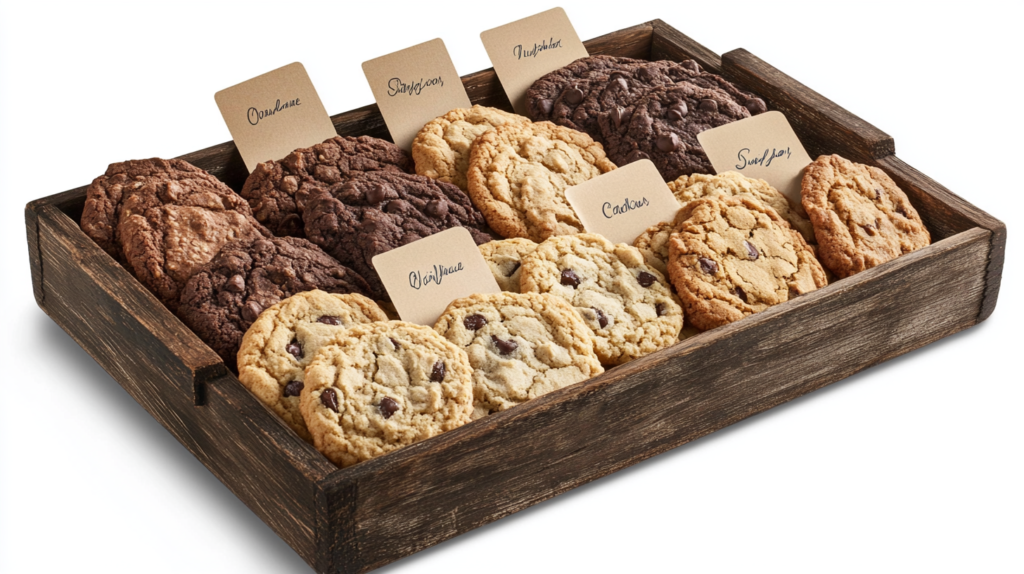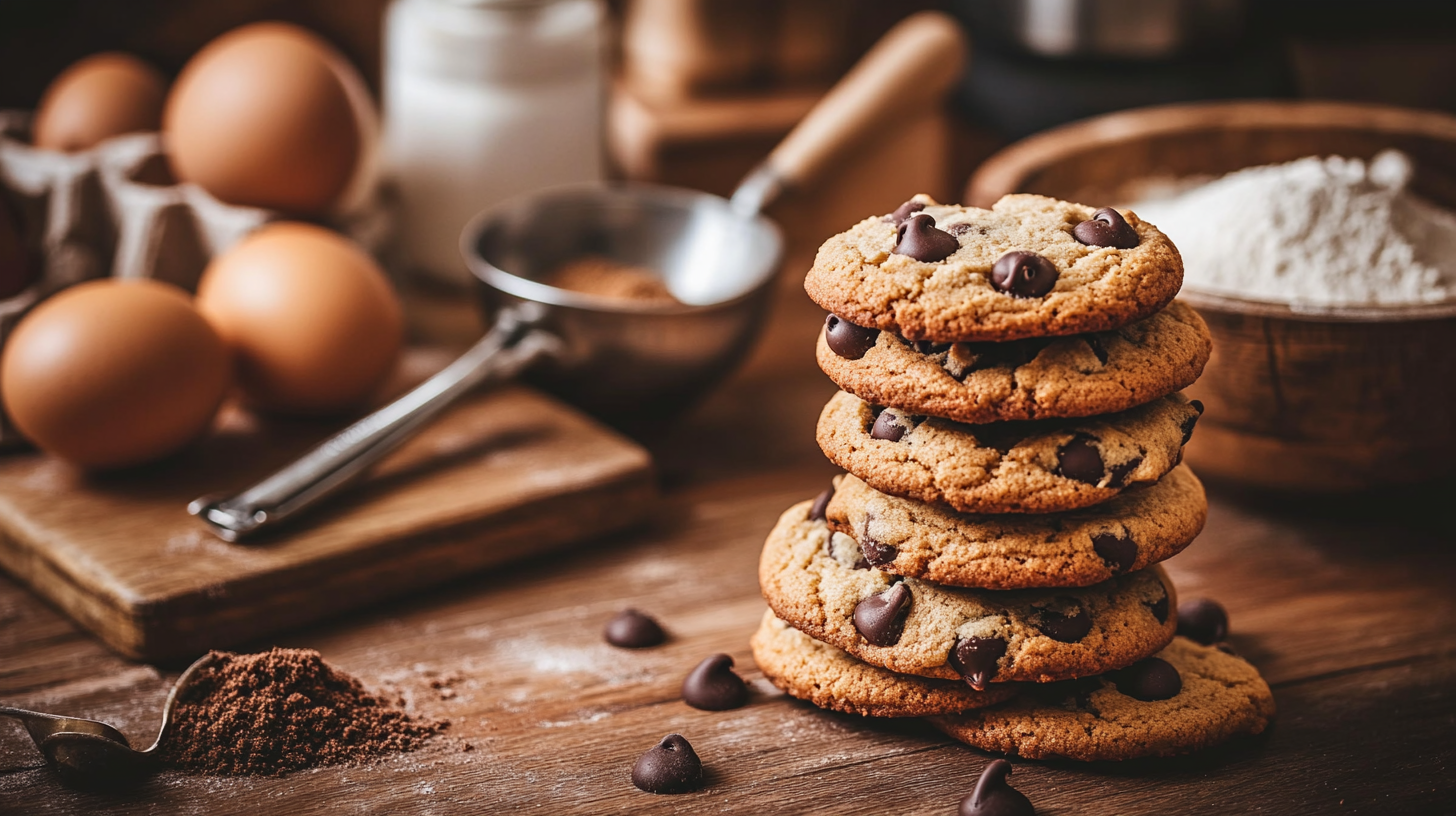Have you ever taken a bite of a cookie that’s so soft and chewy it practically melts in your mouth? Chances are, brown sugar played a big role in making that cookie irresistible. But what exactly does brown sugar do in cookies? If you’ve ever wondered why some recipes specifically call for brown sugar instead of white sugar, you’re in the right place. Let’s dive deep into the magic of brown sugar in baking and uncover why it’s a game-changer for your favorite cookies. 🍪
Table of Contents
Introduction to Brown Sugar in Baking
Brown sugar is like the unsung hero of the baking world. It’s not as flashy as chocolate chips or as colorful as sprinkles, but when it comes to cookies, it can be the difference between “meh” and “wow.” Whether you’re making chocolate chip cookies, oatmeal raisin, or snickerdoodles, brown sugar has a unique ability to elevate your recipe to the next level. But why is that?
The Unique Role of Sugar in Baking
Before we dive into brown sugar specifically, let’s take a quick look at why sugar is so important in baking. Sugar does more than just make things sweet it also affects texture, color, and even how your cookies spread. Think of sugar as the multitasking overachiever of your cookie ingredients.
Sugar doesn’t just sweeten your cookies; it acts as a tenderizer, a caramelizer, and even a moisture-retainer.
Brown Sugar vs. White Sugar: Key Differences

You’ve probably noticed that some cookie recipes call for brown sugar, others for white sugar, and sometimes a mix of both. So, what’s the difference?
- Brown Sugar: Contains molasses, which gives it a moist texture and a rich, caramel-like flavor.
- White Sugar: A drier sugar that’s all about sweetness and crispiness without adding much flavor.
The molasses in brown sugar is the secret ingredient that makes cookies softer and chewier. If white sugar is the crispy cookie specialist, brown sugar is the chewy cookie expert.
What Does Brown Sugar Do in Cookies? The Science Behind It
What Is Brown Sugar?
Let’s break it down. Brown sugar is basically white sugar with molasses mixed in. That’s it! Depending on the type of brown sugar, the molasses content can vary:
- Light Brown Sugar: About 3.5% molasses, perfect for a mild flavor.
- Dark Brown Sugar: About 6.5% molasses, offering a deeper, richer taste.
So when you’re baking cookies, you’re not just adding sweetness with brown sugar you’re also adding moisture and flavor complexity.
How Brown Sugar Affects Cookie Texture

Here’s where things get interesting. The moisture in brown sugar creates steam when heated, which keeps cookies soft and chewy. Think of it like a sponge it holds onto water, which keeps your cookies from drying out.
On the flip side, white sugar doesn’t have that extra moisture, so it creates a crispier texture. This is why recipes with a mix of brown and white sugar often strike the perfect balance between chewy and crispy.
The Impact of Moisture in Brown Sugar
Because of its molasses content, brown sugar has a slightly sticky texture. This means it helps cookies retain moisture even after they’ve cooled down. Ever wonder why some cookies stay soft for days while others turn into hockey pucks? Yep, that’s the brown sugar doing its job. 🙌
Flavor Enhancement: What Does Brown Sugar Do in Cookies?
How Brown Sugar Adds a Rich Flavor
If cookies were a band, brown sugar would be the bass guitar subtle but essential. Its molasses content gives cookies a slightly caramel-like flavor that you just don’t get from white sugar. This extra depth makes your cookies taste more complex and, let’s be honest, downright delicious.
Fun fact: The caramel-like flavor of brown sugar pairs especially well with warm spices like cinnamon, nutmeg, and cloves.
The Caramelization Process in Baking
When you bake cookies, the heat causes sugar to break down and caramelize. This process not only deepens the flavor but also adds a beautiful golden-brown color to your cookies. Brown sugar, with its molasses content, caramelizes differently than white sugar, resulting in a richer color and flavor.
Why Brown Sugar Is Preferred for Certain Cookie Recipes
Not all cookies are created equal. Recipes that focus on soft and chewy textures, like chocolate chip or oatmeal cookies, often call for brown sugar because of its moisture content and flavor profile. On the other hand, if you’re aiming for crispy sugar cookies, white sugar is your best bet.
Pro tip: If you love chewy cookies, stick to recipes that use at least 50% brown sugar in the sugar mix.
Common Problems When Using Brown Sugar in Cookies and Solutions
Cookies Too Soft: What Went Wrong?
Sometimes, cookies can turn out too soft, almost to the point of falling apart. This usually happens if you use too much brown sugar or underbake them. The solution? Stick to the recipe’s measurements and make sure your cookies are baked until the edges are lightly golden.
Hard or Crumbly Cookies: Fixes and Solutions
Hard cookies are often a result of using too little brown sugar or overbaking. Remember, brown sugar is what keeps your cookies soft and chewy. If you accidentally overbake your cookies, try storing them with a slice of bread in an airtight container the bread will help soften them. 🥖
Uneven Baking: Troubleshooting Tips
Uneven cookies can happen if your brown sugar isn’t evenly incorporated into the dough. Always cream your butter and sugar thoroughly to ensure even distribution. Also, make sure your oven temperature is accurate a poorly calibrated oven can wreak havoc on your baking!
Nutrition Facts: What Does Brown Sugar Do in Cookies?
| Nutrient | Per Cookie (Approx.) |
|---|---|
| Calories | 150 |
| Total Fat | 7g |
| Sugar | 12g |
| Protein | 2g |
What Does Brown Sugar Do in Cookies? Substitutes to Try
What if you’re all set to bake, only to realize you’re out of brown sugar? Don’t worry; you’ve got options! While nothing perfectly replicates the magic of brown sugar, there are substitutes that can get the job done. Let’s break down the best alternatives and when to use them.
Can You Replace Brown Sugar with White Sugar?
Yes, you can replace brown sugar with white sugar in a pinch, but it will change the texture and flavor of your cookies. White sugar doesn’t have molasses, so your cookies will lack that signature chewiness and caramel flavor. They’ll also turn out crisper. If chewy isn’t a dealbreaker, go for it! Just use an equal amount of white sugar.
DIY Brown Sugar Substitute
If you’ve got molasses at home, you can easily make your own brown sugar:
- Light Brown Sugar: Mix 1 cup of white sugar with 1 tablespoon of molasses.
- Dark Brown Sugar: Mix 1 cup of white sugar with 2 tablespoons of molasses.
Simply combine the ingredients with a fork or mixer until they’re fully blended. Boom you’ve got brown sugar! This homemade version works just as well in cookies.
Other Brown Sugar Alternatives
If molasses isn’t an option, here are some substitutes to try:
- Honey: Adds moisture and sweetness but changes the flavor slightly.
- Coconut Sugar: A natural option that mimics the texture of brown sugar, though it’s less moist.
- Maple Syrup: Works best when combined with white sugar to maintain texture.
Remember, substitutions can slightly alter the taste and texture of your cookies. Experiment to find what works best for you!
What Does Brown Sugar Do in Cookies? Storage & Measuring Tips
Keeping your brown sugar fresh and properly measuring it can make all the difference in your baking. Let’s go over some pro tips to ensure your brown sugar always works its magic.
How to Prevent Brown Sugar from Hardening
Brown sugar has a bad habit of turning into a solid brick if not stored properly. Here are some tips to keep it soft:
- Airtight Containers: Store brown sugar in a tightly sealed container or ziplock bag.
- Moisture Retainers: Add a slice of bread, a marshmallow, or a brown sugar saver to keep it soft.
- Quick Fix: If your sugar has hardened, microwave it for 10-20 seconds with a damp paper towel to soften it up.
Best Practices for Measuring Brown Sugar
Unlike white sugar, brown sugar needs to be packed when measuring. Why? The molasses creates air pockets that can throw off your measurements if you don’t pack it down. Here’s how to do it:
- Spoon the sugar into your measuring cup.
- Press it down firmly with the back of a spoon or your fingers.
- Repeat until the sugar is level with the rim of the cup.
Packed brown sugar ensures you’re getting the right amount for perfectly chewy cookies every time.
Popular Cookie Recipes: What Does Brown Sugar Do in Cookies?

Now that we’ve covered the basics, let’s get to the fun part baking! Here are three classic cookie recipes where brown sugar truly shines.
Classic Chocolate Chip Cookies
There’s a reason chocolate chip cookies are everyone’s favorite. The brown sugar adds a chewy texture and caramel flavor that pairs perfectly with gooey chocolate chips.
| Ingredient | Quantity |
|---|---|
| Brown Sugar | 3/4 cup |
| White Sugar | 1/4 cup |
| Butter | 1/2 cup |
| Flour | 1 1/2 cups |
| Chocolate Chips | 1 cup |
Tip: For extra chewy cookies, chill the dough for 30 minutes before baking. Trust me, it’s worth the wait! 🕒
Chewy Oatmeal Raisin Cookies
If comfort food were a cookie, this would be it. Brown sugar keeps these cookies soft and chewy, while raisins add a burst of natural sweetness. Add a pinch of cinnamon for a cozy flavor boost!
Brown Sugar Snickerdoodles
Snickerdoodles get a delicious upgrade with brown sugar. The molasses adds a deeper flavor that pairs beautifully with the cinnamon-sugar coating. It’s like a hug in cookie form. 🥰
Pro tip: Swap out some of the white sugar in any cookie recipe for brown sugar to instantly make them chewier.
Expert Tips for Baking Perfect Cookies with Brown Sugar
Ready to level up your baking game? Here are some tips from the pros to ensure your cookies are always a hit.
Temperature Control in Baking
Did you know that the temperature of your ingredients can affect your cookies? Always use room-temperature butter and eggs unless the recipe says otherwise. This helps the brown sugar mix evenly, giving your cookies a consistent texture.
The Ideal Baking Time and Cooling Process
Overbaking is the enemy of chewy cookies. Take them out of the oven when the edges are golden but the centers still look slightly underdone. They’ll continue to bake as they cool, leaving you with perfectly soft cookies.
Once baked, let the cookies cool on the baking sheet for 2-3 minutes before transferring them to a wire rack. This helps them set without falling apart.
“When in doubt, underbake! You can always bake longer, but you can’t unbake a cookie.” 🍪
Frequently Asked Questions About Brown Sugar in Cookies
When it comes to baking with brown sugar, you might still have a few questions. Don’t worry I’ve got answers to the most common ones!
Can You Use Dark Brown Sugar Instead of Light Brown Sugar?
Yes, you can! The main difference between light and dark brown sugar is the molasses content. Dark brown sugar has more molasses, which means it will add a stronger caramel flavor and a slightly darker color to your cookies. If you love bold flavors, dark brown sugar is an excellent choice. Just be mindful that it might make the cookies a tad softer due to the extra moisture.
Does Brown Sugar Change Cookie Color?
Absolutely. Brown sugar gives cookies a golden-brown or even slightly darker appearance compared to white sugar. This is due to the molasses caramelizing during baking. If you’re aiming for a lighter cookie, you can reduce the brown sugar or opt for a mix of brown and white sugar.
Why Do Some Recipes Use Both Brown and White Sugar?
Recipes that combine both sugars aim to strike a balance between chewiness (from the brown sugar) and crispiness (from the white sugar). The blend also adds a more nuanced flavor, making the cookies taste even better.
Can You Make Cookies Without Brown Sugar?
You can, but the cookies will be different. Without brown sugar, you’ll lose some of the chewiness and depth of flavor. If you don’t have brown sugar, try one of the substitutes we mentioned earlier for the best results.
Conclusion: Why Brown Sugar Is a Game-Changer in Cookies
So, what does brown sugar do in cookies? To sum it up, it’s the secret ingredient that takes your cookies from good to absolutely amazing. From adding moisture and chewiness to creating a rich caramel flavor, brown sugar is truly the MVP of cookie baking. Whether you’re a seasoned baker or just starting out, understanding the role of brown sugar can help you bake cookies that everyone will rave about.
Now that you know the science and tips behind baking with brown sugar, it’s time to hit the kitchen and put that knowledge to the test. Grab your apron, preheat your oven, and get ready to bake the best cookies of your life. Happy baking! 🍪
Bonus Baking Tip
If you’re experimenting with recipes, try adjusting the ratio of brown to white sugar to see how it impacts the texture and flavor. You might just discover your own signature cookie recipe!
“Baking is both a science and an art brown sugar is your magic ingredient for creating cookies that are soft, chewy, and full of flavor.”
Ready to Bake? Let’s Recap!
- Brown sugar: Adds moisture, chewiness, and rich flavor.
- Molasses content: The key to its unique properties.
- Substitutes: Honey, coconut sugar, or DIY brown sugar with molasses.
- Pro tips: Use room-temperature ingredients, pack your sugar, and avoid overbaking.
With these tips and tricks, you’re all set to bake cookies that will impress everyone from family and friends to your taste buds. Happy baking, and don’t forget to share the joy (and cookies)! 😊
People also ask
- Easy Chocolate Chip Cookies Without Brown Sugar
- Soft and Chewy Cookies: 10 Proven Secrets
- What Is the Secret to Making Soft Cookies?
- Soft Chocolate Chip Cookies

Brown Sugar Changes Cookies
Equipment
- Mixing Bowls: At least two (one for creaming and one for dry ingredients)
- Electric Mixer or Hand Whisk: For creaming the butter and sugars
- Measuring Cups & Spoons: For precise ingredient measurements.
- Spatula: To fold ingredients together
- Baking Sheet: To spread out the cookie dough
- Parchment Paper or Silicone Baking Mat: For lining the baking sheet
- Cooling Rack: To cool the cookies after baking
- Oven: Preheated to the proper temperature
Ingredients
- 1 cup 226 g unsalted butter, softened
- 1 cup 220 g packed light or dark brown sugar
- ½ cup 100 g granulated sugar
- 2 large eggs at room temperature
- 2 teaspoons vanilla extract
- 2 cups 240 g all-purpose flour
- 1 teaspoon baking soda
- ½ teaspoon salt
- Optional Add-ins:
- 1 cup chocolate chips walnuts, or pecans for added texture and flavor
- ½ teaspoon ground cinnamon for a warm spice note
Instructions
- Preheat the Oven:
- Preheat your oven to 350°F (175°C). Line a baking sheet with parchment paper or a silicone mat.
- Cream Butter and Sugars:
- In a large mixing bowl, beat the softened butter, brown sugar, and granulated sugar together on medium speed until the mixture is light and fluffy (about 2–3 minutes).
- Add Eggs and Vanilla:
- Beat in the eggs one at a time, ensuring each is fully incorporated before adding the next. Stir in the vanilla extract.
- Mix Dry Ingredients:
- In a separate bowl, whisk together the all-purpose flour, baking soda, and salt. (If using cinnamon, add it here.)
- Combine Wet and Dry Mixtures:
- Gradually add the dry ingredients to the butter mixture. Mix on low speed or fold gently with a spatula until just combined. Be careful not to overmix, which can lead to tough cookies.
- Fold in Optional Add-ins:
- If you’re using chocolate chips, nuts, or other mix-ins, gently fold them into the dough until evenly distributed.
- Portion the Dough:
- Drop rounded tablespoons (or use a small cookie scoop) of dough onto the prepared baking sheet, spacing them about 2 inches apart.
- Bake:
- Bake in the preheated oven for 10–12 minutes, or until the edges are lightly golden but the centers still look soft. (For a slightly crispier cookie, bake an extra minute.)
- Cool:
- Remove the cookies from the oven and let them sit on the baking sheet for 5 minutes before transferring them to a cooling rack to cool completely.
- Details
- Prep Time: 15 minutes
- Cook Time: 10–12 minutes per batch
- Total Time: Approximately 30 minutes
- Yield: About 24 cookies (depending on the size you make)
- Category: Cookies, Desserts, Snacks
- Method: Baking
- Cuisine: American
- Diet: Vegetarian (to make them vegan, substitute dairy butter with a plant-based alternative and use flax eggs)
- Keywords
- chewy cookies, brown sugar cookies, caramel flavor, easy dessert, homemade cookies, baking, snack, American cookies
- Nutrition
- (Approximate values per cookie; based on a yield of 24 cookies)
- Serving Size: 1 cookie (approx. 35 g)
- Calories: ~163
- Total Sugar: ~11 g
- Sodium: ~100 mg
- Total Fat: ~8 g
- Saturated Fat: ~5 g
- Unsaturated Fat: ~3 g
- Trans Fat: 0 g
- Carbohydrates: ~22 g
- Dietary Fiber: ~0.5 g
- Protein: ~2 g
- Cholesterol: ~30 mg
- Note: These values are estimates. The nutritional content may vary slightly based on ingredient brands and any optional add-ins you choose.
Notes
Texture Tips: For a softer, chewier cookie, slightly underbake; for a crispier edge, bake an extra minute.
Ingredient Quality: Using high-quality butter and fresh vanilla extract will enhance the overall flavor.
Variations: Experiment with add-ins like chopped nuts, dried fruit, or a sprinkle of sea salt on top before baking for extra flavor contrasts.
Allergy Note: Ensure that all ingredients are suitable for your dietary needs (e.g., gluten-free substitutions or dairy alternatives can be used if required).
Enjoy baking these delightful Brown Sugar Changes Cookies and feel free to tweak the recipe to suit your taste!
